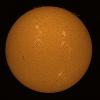Astronomy
The Universe's First Stars Unveiled in Turbulent Simulations
What was the Universe like before the first stars formed? Dark, obviously. But there must have been some level of activity in the gas clouds that preceded the first stars. New research shows that these primordial clouds were turbulent, clumpy, and supersonic.
Categories: Astronomy
Microwaving rocks could help mining operations pull CO2 out of the air
A carbon dioxide removal company in Canada is experimenting with ways to treat mining waste to capture and store more CO2
Categories: Astronomy
Microwaving rocks could help mining operations pull CO2 out of the air
A carbon dioxide removal company in Canada is experimenting with ways to treat mining waste to capture and store more CO2
Categories: Astronomy
Skyrora becomes 1st British company to get license to launch from the UK
Scotland-based Skyrora has received the first U.K.-issued vertical launch license for a homegrown company, enabling rocket launches from SaxaVord Spaceport in the Shetland Islands.
Categories: Astronomy
Can you name all the planets in order in the solar system? Try our new quiz to find out!
Our quiz will test your smarts of which planets go where in our solar system.
Categories: Astronomy
Working past the age of retirement may improve your life satisfaction
Having a full-time job in later life has been linked to improved emotional, financial and general life satisfaction - but the results vary a lot between men and women
Categories: Astronomy
Working past the age of retirement may improve your life satisfaction
Having a full-time job in later life has been linked to improved emotional, financial and general life satisfaction - but the results vary a lot between men and women
Categories: Astronomy
Meteorite that punched a hole through Georgia roof may be older than Earth itself
"This particular meteor that entered the atmosphere has a long history before it made it to the ground of McDonough".
Categories: Astronomy
James Webb telescope reveals 'Sleeping Beauty' galaxies in the early universe — snoozing where they weren't supposed to exist
Using data from the James Webb Space Telescope, astronomers have discovered dormant galaxies with a wide range of masses in the first billion years after the Big Bang, moving one step closer to understanding how early galaxies grow.
Categories: Astronomy
Psychedelic drug ibogaine may treat PTSD by slowing brainwaves
In people with traumatic brain injury, administering the psychedelic drug ibogaine seems to slow down brainwaves, which may explain why it helps treat PTSD
Categories: Astronomy
Psychedelic drug ibogaine may treat PTSD by slowing brainwaves
In people with traumatic brain injury, administering the psychedelic drug ibogaine seems to slow down brainwaves, which may explain why it helps treat PTSD
Categories: Astronomy
Lost researcher's remains found on Antarctic glacier after 66 years
Bone fragments found on King George Island have been identified as Dennis "Tink" Bell, a British meteorologist who fell into a crevasse in 1959
Categories: Astronomy
Lost researcher's remains found on Antarctic glacier after 66 years
Bone fragments found on King George Island have been identified as Dennis "Tink" Bell, a British meteorologist who fell into a crevasse in 1959
Categories: Astronomy
NASA’s SpaceX Crew-10 Splashes Down in Pacific Ocean
Roscosmos cosmonaut Kirill Peskov, left, NASA astronauts Nichole Ayers and Anne McClain, and JAXA (Japan Aerospace Exploration Agency) astronaut Takuya Onishi are seen inside the SpaceX Dragon Endurance spacecraft aboard the SpaceX recovery ship SHANNON shortly after having landed in the Pacific Ocean off the coast of San Diego, Calif., Saturday, Aug. 9, 2025. McClain, Ayers, Onishi, and Peskov returned after 147 days in space as part of Expedition 73 aboard the International Space Station.
'Alien: Earth' cast talks 'Peter Pan' references, AI warnings, and navigating complex roles (exclusive)
Before the Xenomorph crash-lands on streaming, we talked to five Alien: Earth cast members about the difficulties and fun of navigating the giant sci-fi show.
Categories: Astronomy
The Perseid Meteor Shower Is Peaking. Here’s How to Watch
The Perseids are the best annual meteor shower, but this year’s show will be dimmed by a bright gibbous moon
Categories: Astronomy
A new measure of health is revolutionising how we think about ageing
Life expectancy has increased dramatically over the past century, but our years of good health appear not to have kept pace. Now, a new lens on what it means to age well is reshaping our view of our golden years
Categories: Astronomy
A new measure of health is revolutionising how we think about ageing
Life expectancy has increased dramatically over the past century, but our years of good health appear not to have kept pace. Now, a new lens on what it means to age well is reshaping our view of our golden years
Categories: Astronomy
Extreme heat is driving dramatic declines in tropical birds
The numbers of many tropical birds are plummeting, and now it has been shown that heat extremes intensified by global warming are the biggest factor driving these declines
Categories: Astronomy


